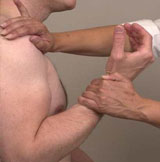 Graded and Redefined Assessment of Strength, Sensibility and Prehension
Graded and Redefined Assessment of Strength, Sensibility and Prehension
The GRASSP is a new outcome measure for patients with a cervical spinal cord injury, which is developed and evaluated by an international team since May 2006.
The aim of the GRASSP is to assess hand function in tetraplegic patients in all stages after injury and to document changes of the impairment over time.
The GRASSP consists of three domains:
1. Strength: manual muscle testing of 10 muscles of the upper limb
2. Sensation: Semmes-Weinstein Monofilament testing
3. Prehension:
- qualitative description of relevant finger/hand positioning for grasping
- grasping test with 6 ADL activities
Reliability and validity of the GRASSP were established in an international multi-centre study. Further evaluation of the GRASSP, such as responsiveness, minimally clinical important differences and more, are subject of a study currently taking place in several collaborating centers in Europe, the US and Canada.
For further information about the GRASSP and acquisition possibilities: http://www.toronto-fes.ca/axal/
Also see: GRASSP Study


Domain 1 Domain 2

Domain 3
1. Kalsi-Ryan S., et al., The Graded Redefined Assessment of Strength Sensibility and Prehension (GRASSP): Reliability and Validity. J Neurotrauma. 2011 Aug 12. [Epub ahead of print]
2. Kalsi-Ryan S., et al., Assessment of the Hand in Tetraplegia Using the Graded Redefined Assessment of Strength, Sensibility and Prehension (GRASSP): Impairment Versus Function.
© GRASSP Copyright 2008 International GRASSP Research and Design Team, All Rights Reserved

